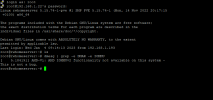Hi,
I recently just completed building my home server and was trying to setup a TrueNAS VM. The only problem that I'm having is that the HDDs are not appearing within the TrueNAS installation setup. When I go back to proxmox I can see all three disks. I was wondering if there was a configuration step or issue I might've of missed. Here are some things I did before setting up the VM:
1) Wiped all three disks and initialized them with GPT
2) When creating the TrueNAS VM, I switched the machine under the "System" tab to "q35"
3) All three disks aren't connected to an HBA but directly to the SATA ports on my motherboard
4) System Specs: Ryzen 5600G, Asrock B550M-ITX/ac, 16GB DDR4, 256GB TeamGroup NVME SSD (Boot Drive), 3x WD Red Pro NAS HDDs FFBX.
I'm open to switching to a different NAS option if that resolves my issue. Sorry if this questions has already been asked as I couldn't find it.
I recently just completed building my home server and was trying to setup a TrueNAS VM. The only problem that I'm having is that the HDDs are not appearing within the TrueNAS installation setup. When I go back to proxmox I can see all three disks. I was wondering if there was a configuration step or issue I might've of missed. Here are some things I did before setting up the VM:
1) Wiped all three disks and initialized them with GPT
2) When creating the TrueNAS VM, I switched the machine under the "System" tab to "q35"
3) All three disks aren't connected to an HBA but directly to the SATA ports on my motherboard
4) System Specs: Ryzen 5600G, Asrock B550M-ITX/ac, 16GB DDR4, 256GB TeamGroup NVME SSD (Boot Drive), 3x WD Red Pro NAS HDDs FFBX.
I'm open to switching to a different NAS option if that resolves my issue. Sorry if this questions has already been asked as I couldn't find it.




